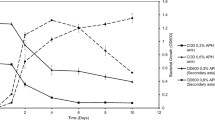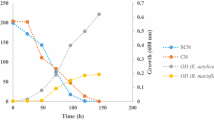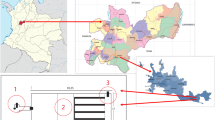Abstract
Industrial wastewater from the production of sulfur containing esters and the resulting products of this synthesis, 2-ethylhexylthioglycolic acid (EHTG) and iso-octylthioglycolic acid (IOTG), were deployed in this study to enrich novel bacterial strains, since no wastewater and EHTG or IOTG degrading microorganisms were hitherto described or available. In addition, nothing is known about the biodegradation of these thiochemicals. The effect of this specific wastewater on the growth behaviour of microorganisms was investigated using three well-known Gram-negative bacteria (Escherichia coli, Pseudomonas putida, and Ralstonia eutropha). Concentrations of 5% (v/v) wastewater in complex media completely inhibited growth of these three bacterial strains. Six bacterial strains were successfully isolated, characterized and identified by sequencing their 16S rRNA genes. Two isolates referred to as Achromobacter sp. strain MT-E3 and Pseudomonas sp. strain MT-I1 used EHTG or IOTG, respectively, as well as the wastewater as sole source of carbon and energy for weak growth. More notably, both isolates removed these sulfur containing esters in remarkable amounts from the cultures supernatant. One further isolate was referred to as Klebsiella sp. strain 58 and exhibited an unusual high tolerance against the wastewater’s toxicity without utilizing the contaminative compounds. If cultivated with gluconic acid as additional carbon source, the strain grew even in presence of more than 40% (v/v) wastewater. Three other isolates belonging to the genera Bordetella and Pseudomonas tolerated these organic sulfur compounds but showed no degradation abilities.





Similar content being viewed by others
Abbreviations
- DSMZ:
-
Deutsche Sammlung von Mikroorganismen und Zellkulturen
- TG:
-
Thioglycolic acid
- EH:
-
2-Ethyl-1-hexanol
- MSM:
-
Mineral salt medium
- EHTG:
-
2-Ethylhexylthioglycolic acid
- IOTG:
-
Iso-octylthioglycolic acid
- LB:
-
Luria Bertani broth
- OSC:
-
Organic sulfur compounds
- Na:
-
Sodium
References
Angenent LT, Karim K, Al-Dahhan MH, Wrenn BA, Dominguez-Espinosa R (2004) Production of bioenergy and biochemicals from industrial and agricultural wastewater. Trends Biotechnol 9:477–485
Birnboim HC, Doly J (1979) A rapid alkaline extraction procedure for screening recombinant plasmid DNA. Nucleic Acids Res 7:1513–1523
Bruland N, Wübbeler JH, Steinbüchel A (2009a) 3-Mercaptopropionate dioxygenase, a cysteine dioxygenase homologue, catalyzes the initial step of 3-mercaptopropionate catabolism in the 3, 3′-thiodipropionic acid degrading bacterium Variovorax paradoxus. J Biol Chem 284:660–672
Bruland N, Bathe S, Willems A, Steinbüchel A (2009b) Pseudorhodoferax soli gen. nov., sp. nov., and Pseudorhodoferax caeni sp. nov., betaproteobacteria belonging to the family Comamonadaceae. Int J Syst Evol Microbiol. doi:10.1099/ijs.0.006791-0
Carbajal-Rodríguez I, Bruland N, Wübbeler JH, Steinbüchel A (2009) Aerobic degradation of mercaptosuccinate by the Gram-negative bacterium Variovorax paradoxus strain B4 (in preparation)
Edwards PR, Fife MA (1955) Studies on the Klebsiella-Aerobacter group of bacteria. J Bacteriol 70:382–390
Garcia-Ruiz V, Martin-Otero LE, Puyet A (2002) Transformation of thiodiglycol by resting cells of Alcaligenes xylosoxidans PGH10. Biotechnol Prog 18:252–256
Gerhardt P, Murry RGE, Wood WA, Krieg NR (1994) Methods for general and molecular bacteriology. American Society for Microbiology, Washington, DC
Hanahan D (1983) Studies on transformation of Escherichia coli with plasmids. J Mol Biol 136:557–580
Hollenbach K, Schmidt P, Stremmel D (1972) Animal experiment studies on the effects of thioglycolic acid iso-octylester, thioglycolic acid and 2-ethylhexanol on blood pressure. Z Gesamte Hyg 18:481–485
Innis MA, Gelfaud DH, Suinsky JJ, White TJ (1990) PCR-protocol: a guide to methods and applications. Academic Press, San Diego
Kim JW, Rainina EI, Efremenko E, Engler CR, Wild JR (1997) Degradation of thiodiglycol, the hydrolysis product of sulfur mustard, with bacteria immobilized within poly(vinyl)alcohol cryogels. Biotechnol Lett 19:1067–1071
Kwot TT, Chen P, Liu PY, Tang YC, Kong SK, Fung KP, Choy YM (2002) The anti-tumour effect of Klebsiella pneumoniae capsular polysaccharides. Biol Signals Recept 10:294–298
Lee TS, Chan SH, Weigand WA, Bentley WE (2000) Biocatalytic transformation of [(2-hydroxyethyl)thio]acetic acid and thiodiglycolic acid from thiodiglycol by Alcaligenes xyolosoxidans ssp. xylosoxidans (SH91). Biotechnol Prog 16:363–367
Maidak BL, Olsen GJ, Larsen N, Overbeek R, McCaughey MJ, Woese CR (1997) The RDP (ribosomal database project). Nucleic Acids Res 25:109–111
Mantzavinos D, Kalogerakis N (2005) Treatment of olive oil effluents Part I. Organic matter degradation by chemical and biological processes—an overview. Environ Int 31:289–296
Marmur J (1961) A procedure for the isolation of desoxyribonucleic acid from microorganisms. J Mol Biol 1:208–218
Page RDM (1996) Treeview: an application to display phylogenetic trees on personal computers. Comput Appl Biosci 12:357–358
Pant D, Adholeya A (2007) Biological approaches for treatment of distillery wastewater: a review. Bioresour Technol 98:2321–2334
Pfennig N (1974) Rhodopseudomonas globiformis sp. nov., a new species of the Rhodospirillaceae. Arch Microbiol 100:197–206
Rüdiger A, Rüdiger I, Jurisevic S (2007) Aqua-Biomant: integrated biological and electrochemical oxidation for industrial wastewater treatment. Water Sci Technol 55:195–200
Saitou N, Nei M (1987) The neighbor-joining method: a new method for reconstructing phylogenetic trees. Mol Biol Evol 4:406–425
Sambrook J, Fritsch EF, Maniatis T (1989) Molecular cloning: a laboratory manual, 2nd edn. Cold Spring Laboratory, Cold Spring Harbor, N.Y
Sanger F, Nicklen S, Coulson AR (1977) DNA sequencing with chain-terminating inhibitors. Proc Natl Acad Sci USA 74:5463–5467
Schlegel HG, Kaltwasser H, Gottschalk G (1961) Ein Submersverfahren zur Kultur wasserstoffoxidierender Bakterien: Wachstumsphysiologische Untersuchungen. Arch Mikrobiol 38:209–222
Schmidt P, Fox G, Hollenbach K, Rothe R (1974) Zur akuten Toxizität des Thioglykolsäure-2-äthylhexylesters im Tierversuch. Z Gesamte Hyg 20:575–578
Thompson JD, Gibson TJ, Plewniak F, Jeanmougin F, Higgins DG (1997) The ClustalX windows interface: flexible strategies for multiple sequence alignment aided by quality analysis tools. Nucleic Acids Res 24:4876–4882
Tikhonova EB, Ermakova IT, Slepen’kin AV, Kashparov KI, Starovoitov II, Boronin AM (2002) The bioutilization of thiodiglycol (a breakdown product of mustard gas): isolation of degraders and investigation of degradation conditions. Microbiologiia 71:247–252
Wübbeler JH, Lütke-Eversloh T, Vandamme P, Van Trappen S, Steinbüchel A (2006) Tetrathiobacter mimigardefordensis sp. nov., isolated from compost, a betaproteobacterium capable of utilizing the organic disulfide 3, 3′-dithiodipropionic acid. Int J Syst Evol Microbiol 56:1305–1310
Wübbeler JH, Bruland N, Kretschmer K, Steinbüchel A (2008) A novel pathway for the catabolism of the organic sulfur compound 3, 3′-dithiodipropionic acid via 3-mercaptopropionic acid and 3-sulfinopropionic acid to propionyl-CoA by the aerobic bacterium Tetrathiobacter mimigardefordensis strain DPN7. Appl Environ Microbiol 74:4028–4035
Wübbeler JH, Bruland N, Wozniczka M, Steinbüchel A (2009) Biotechnological applications and microbial utilisation of the organic sulphur compounds 4,4′-dithiodibutyric acid, 3,3′-dithiodipropionic acid and 3,3′-thiodipropionic acid (Submitted)
Acknowledgments
The authors thank the company Bruno Bock Chemische Fabrik GmbH & Co KG (Niedermarschacht, Germany) for providing wastewater samples and information about its chemical composition as well as bulk containers of EHTG, IOTG and TG.
Author information
Authors and Affiliations
Corresponding author
Rights and permissions
About this article
Cite this article
Toups, M., Wübbeler, J.H. & Steinbüchel, A. Microbial utilization of the industrial wastewater pollutants 2-ethylhexylthioglycolic acid and iso-octylthioglycolic acid by aerobic Gram-negative bacteria. Biodegradation 21, 309–319 (2010). https://doi.org/10.1007/s10532-009-9302-y
Received:
Accepted:
Published:
Issue Date:
DOI: https://doi.org/10.1007/s10532-009-9302-y




